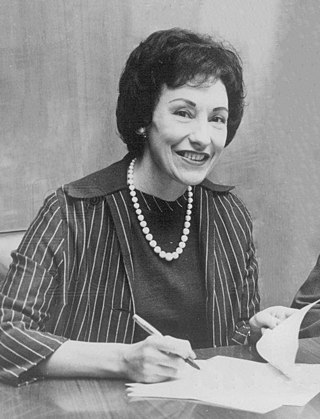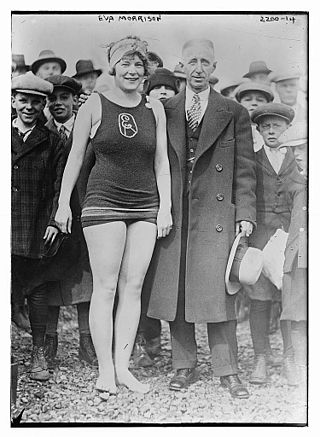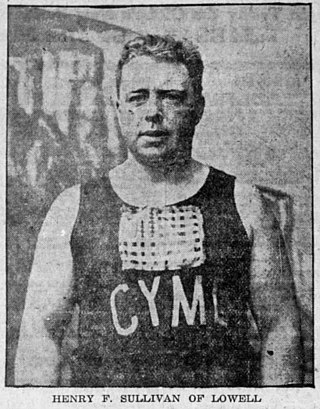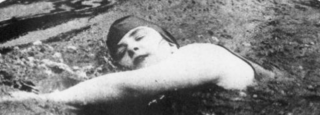 | |
| Personal information | |
|---|---|
| Born | April 19, 1895 Dorchester, Massachusetts |
| Died | June 15, 1984 (aged 89) |
| Sport | |
| Sport | Swimming |
Rose Pitonof Weene (April 19, 1895 – June 15, 1984) was a marathon swimmer from Dorchester, Massachusetts. [1]
 | |
| Personal information | |
|---|---|
| Born | April 19, 1895 Dorchester, Massachusetts |
| Died | June 15, 1984 (aged 89) |
| Sport | |
| Sport | Swimming |
Rose Pitonof Weene (April 19, 1895 – June 15, 1984) was a marathon swimmer from Dorchester, Massachusetts. [1]
Pitonof was born on April 19, 1895, to Eli Pitonof and Fanny Wolf in Dorchester, Boston. Her parents owned a grocery store together, and Eli served as Rose's manager until his death due to the outbreak of the 1918 flu pandemic after the First World War.
Pitonof was raised with four other siblings, three brothers Adolf, Benny, and Louis, and a sister Ida. Adolf was in the boat with her coach during her successful East 26th Street to Steeplechase Pier swim.
On September 18, 1910, at the age of 15, Pitonof was first woman to have successfully swum a 17-mile stretch around the waters surrounding New York City and was the first person to have completed the course from East Twenty-fourth St., to Coney Island, finishing in four and a half hours without any outside assistance. [2]
Earlier that year, on August 7, 1910, Pitonof won the Boston Light Swim, an eight-mile open water event, in a record time of 6 hours and 50 minutes. Seven men started the competition with her, but none apart from her successfully finished. She was the first woman to ever complete the event. Her record stood for several years, and her unprecedented success in the Boston Light Swim was noted in a 1912 Chicago Tribune article titled, "Is There Anything Women Can't Do?"
After her Boston Light Swim, Pitonof became a Vaudeville performer.
"My act was part of a larger Vaudeville program, but I was the headliner. I know for a good, good many years I held a record for attendance. They built a tank of water on the stage, and I would exhibit some of my strokes and dives," she said.

Pitonof's performances were not strictly entertainment based. Her demonstrations also included important life saving skills: "In conjunction to Rose Pitonof's swimming and diving exhibitions, she will demonstrate how to save a person from drowning. Miss Pitonof has, during her young life, saved several from a watery end, and in her performances this afternoon, you will witness an exhibition that will interest and instruct. A crowded house will no doubt greet this little Boston school girl, who has won the title of World's Champion Long Distance Swimmer."
During the early 1900s, many people did not know how to swim, and in many cases learning how to swim was actively discouraged among women.
The General Slocum tragedy of June 15, 1904, in which 1021 passengers died trying to save themselves from a burning boat that was banked in seven feet of water less than 20 feet from shore, was a heartbreaking illustration of this situation. This was the single greatest instance of loss of life in the New York City area until the World Trade Center terrorist attacks on September 11, 2001.
On September 18, 1910, Pitonof swam from East 23rd Street to a half mile away from Steeplechase Pier, winning a race against Mrs. Clara Bouton. On their way to Coney Island, they swam past the East 5th Street pier that the ill-fated General Slocum launched from.
On August 13, 1911, Pitonof swam from East 26th Street to Steeplechase Pier, earning the woman's title of Long Distance Swimming Champion of the World. The distance between the two points is 17 miles. It is estimated that Pitonof covered 21 miles during eight hours and seven minutes in the water. She swam mostly breast stroke, occasionally passing underneath piers. Her nutrition for the day was a chicken sandwich and a cup of coffee before she started her swim. It is estimated that a crowd of 50,000 were cheering for her at Coney Island. The annual Rose Pitonof Swim along the same route commemorates her achievement. [3]
A year later Pitonof headed to England to attempt to swim across English Channel. In August 1912 she was forced to delay her Channel Swim until September due to storms. While she waited for better weather, she swam the Thames River. In September 1912 she was again prevented from attempting the Channel due to heavy winds.
In 1913 Pitonof made a couple of attempts at swimming from the Manhattan Battery to Sandy Hook, New Jersey. On July 20, 1913, the tide was against her, and she was forced to abandon the attempt after two miles. On September 14, 1913, just a quarter of a mile away from her goal, Pitonof was taken into the boat due to an attack of cramps. She had been in the water 12 hours and 35 minutes.
During the First World War, attempts at swimming the English Channel were curtailed. It was not until August 6, 1926, that Gertrude Ederle became the first woman to successfully cross the English Channel.
On June 28, 1916, Pitonof married Doctor Fredric Weene, a Boston dentist. It is rumored that she gave up an opportunity to go to Hollywood in order to marry.
The Weene family was a colorful, social couple who spent time with many of the celebrities of the era that they knew from Pitonof's Vaudeville days. They had a house in Onset on Cape Cod, and Pitonof taught swimming in the area, where they had two daughters named Evelyn and Elinor. Of the two daughters, Elinor Weene became a champion swimmer.
There were three grandchildren: Maxine, Sandy, and Carol. Pitonof's granddaughters Sandy and Carol were swimming at 18 months.
Pitonof and her husband moved to Desert Hot Spring, Arizona, in 1948, moving back to the Boston area in later years.
Pitonof died on June 15, 1984, at the age of 89. She is survived by both daughters, all three grandchildren, and four great-grandchildren.
Marilyn Grace Bell Di Lascio is a Canadian retired long distance swimmer. She was the first person to swim across Lake Ontario and later swam the English Channel and Strait of Juan de Fuca.

Captain Matthew Webb was an English seaman, swimmer and stuntman. He is the first recorded person to swim the English Channel for sport without the use of artificial aids. In 1875, Webb swam from Dover to Calais in less than 22 hours. This made him a celebrity, and he performed many stunts in public. He died trying to swim the Niagara Gorge below Niagara Falls, a feat declared impossible.

Gertrude Caroline Ederle was an American competition swimmer, Olympic champion, and world record-holder in five events. On August 6, 1926, she became the first woman to swim across the English Channel. Among other nicknames, the press sometimes called her "Queen of the Waves".

Florence May Chadwick was an American swimmer known for long-distance open water swimming. She was the first woman to swim across the English Channel in both directions, setting a time record each time. She was also the first woman to swim the Catalina Channel, the Straits of Gibraltar, the Bosporus, and the Dardanelles.

Lynne Cox is an American long-distance open-water swimmer, writer and speaker. She is best known for being the first person to swim between the United States and the Soviet Union, in the Bering Strait, a feat which has been recognized for easing the Cold War tensions between U.S. President Ronald Reagan and Soviet leader Mikhail Gorbachev.

Ethel "Sunny" Lowry MBE was credited with becoming the first British woman to swim the English Channel in 1933..
Erica Lara Rose was an American competition swimmer who specialized in long-distance and open water events. Rose was a 5 km World Aquatics champion in Perth, Australia at only fifteen in 1998, was a four-time Pan American swim marathon gold medalist, a Pan Pacific 3.1 mile champion in 1997 in Melbourne, Australia, and a ten-time National Open Water swim marathon champion at 5 km, 10 km, and 25 km distances between 1997 and 2007. She competed with Cleveland's Lake Erie Silver Dolphins, Hawken High School Swim Team, the Northwestern University Swim Team, and for twelve years with the USA Swimming National Team.
Jennifer Figge is an American athlete from Aspen, Colorado, who in 2009 attempted to swim several portions of the Atlantic from Africa to South America, starting on January 12, 2009, at the Cape Verde Islands, and ending in North America in Trinidad and Tobago on February 5. Newspaper accounts reported she covered a distance of roughly 2000 miles.
Jacob Abraham "Jabez" "Jappy" Wolffe was a Scottish long distance swimmer and author of swimming books that attempted to swim the English Channel from 1906 to 1914, coming nearest in September of 1919 in an attempt of 14 hours 55 minutes, from Shakespeare Cliff, Dover, England "to within a quarter of a mile of the French coast", one of 22 failed attempts at this long distance swim. He is also known for the differing historical accounts of his role as a trainer in the first, failed attempt of Gertrude Ederle to swim the channel.

Eva Belle Morrison Abdou was a Boston hospital librarian, and a long-distance swimmer who made three attempts to cross the English Channel, but never succeeded. She was the first female from New England to attempt to swim the English Channel, making three attempts in 1926, 1935, and 1937. She was on the Board of Governors of The International Professional Swimmers' Association.

Henry Francis Sullivan was an American marathon swimmer who is best known for becoming the third person and the first American to swim across the English Channel, beginning his swim on the afternoon of August 5, 1923, from Dover, England, and finishing 26 hours and 50 minutes later on the evening of August 6 at Calais, France.

Amelia "Mille" Gade Corson was a Danish-born American long-distance swimmer who is best known as becoming the seventh person, third American and second woman to successfully swim across the English Channel. Earlier, Corson had completed the swim around Manhattan Island, a distance of 42 miles, and had also completed the swim from Albany, New York, to New York City, swimming the distance in a total of 5 days, 3 hours and 11.5 minutes. The straight-line distance between the two points is 143 miles, but Corson swam an extra 10 miles due to various detours.

Bhakti Sharma is an Indian Open water swimmer.

The L Street Brownies are a polar bear club based in South Boston, Massachusetts. Organized in 1902, it is one of the oldest such clubs in the United States. Although the Brownies swim year round, they are best known for their annual New Year's Day plunge in Dorchester Bay.
Charles "Charlie the Tuna" Chapman is an American distance swimmer specializing in the butterfly stroke, who in 1981 became the first Black swimmer to successfully cross the English channel, and in 1988 set a record for swimming twice around New York's Manhattan Harbor, a 28.5 mile marathon. In 1997, he became the first person to swim twice around Alcatraz Island, departing from San Francisco.
Jenny Marie Ingeborg Kammersgaard (1918-1997) was a Danish female professional long-distance swimmer who rose to fame in the 1930s. Here she swam across inner Danish waters and from Denmark to Germany. Because of her results she was invited by Adolf Hitler to Germany. She was used in the Nazi propaganda as an example of the "aryan" ideal person. After the war she helped refugees getting out of Europe through Sweden. From 1950 she returned to swimming.
Stella Taylor was an American long-distance swimmer born in Bristol, England, best known for crossing the English Channel twice and holding Guinness Book of Records recognition as the oldest woman to swim across the Channel. She made her first English channel crossing in August 1973 in 15:25, from England to France, when she was around the age of 43, repeating the swim in 1975 in 18:15 at the age of 45.

Meenakshi Pahuja is an Indian lecturer and marathon swimmer. After a successful career as a competitive swimmer, she became a teacher at Lady Shri Ram College, and later entered open water swimming. She received a 2018 Nari Shakti Puraskar award.

Ivy Hawke was a British swimmer, swimming instructor, and the fourteenth person to successfully swim across the English Channel.
Miss Rose Pitonof, the seventeen-year-old swimming marvel from Dorchester, Mass., added another wonderful performance to her record yesterday when she successfully negotiated the distance between East Twenty-sixth Street, Manhattan, and Steeplechase Pier, Coney Island.